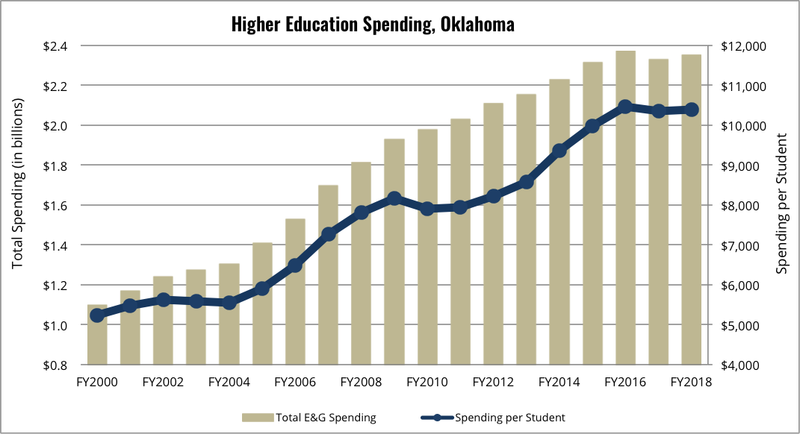
Budget & Tax, Higher Education
Despite higher ed officials' claims, spending at an all-time high
August 14, 2017
Cody Ray Milner
Over the past year, Oklahoma’s higher education administrators have been quick to vocalize a doomsday scenario for Oklahoma’s colleges and universities if the state legislature reduced appropriations again. As we now know, the legislature did indeed cut funding for the 2018 fiscal year, and higher education’s leaders immediately took to the press to bemoan the budget cuts.
- Glenn Johnson, State Chancellor for Higher Education – “The negative impacts of these cuts on academic programs, personnel, student services and degree completion initiatives are devastating.” (Note: Johnson’s annual compensation package is ten times higher than that of the average Oklahoman).
- David Boren, President of the University of Oklahoma – “To offset the drastic budget cuts to higher education over the past few years, OU has implemented a number of strategies to make necessary cuts…These measures cumulatively will cut an estimated $20 million from the Norman campus annual budget.”
- Carrie Hulsey-Greene, Associate Director of Communications for Oklahoma State University – “Because of budget cuts, improvements may be put on hold…there will be fewer class sections and larger class sections.”
- Adrianna Lancaster, Provost of East Central University – “Because of the decrease in state appropriations, East Central University has been evaluating all of our programs and services…unfortunately our programs [at the Ardmore campus] are no longer economically feasible.”
Based on these comments, you’d be forgiven for thinking that due to reduced state funding, all of the public universities in Oklahoma implemented massive spending cuts. However, you’d be wrong.
In the just-released Education and General Budget, Fiscal Year 2018, the primary budget spending for public higher education in 2017-2018 will be $21,000,000 more than last year. Boren’s $20 million in cuts? The Norman campus is actually planning on spending an extra $10 million this year. OSU reducing the number of classes offered? According to the budget, the Stillwater campus will be spending $21 million more than it did last year.
Admittedly, some of the colleges and universities in Oklahoma’s public higher education system will spend less this year than last year. But bear in mind that not only has state funding dropped incrementally, enrollment is also at a fifteen-year low. Last time Oklahoma had this few college students to fund (2002), total educational spending was $1.2 billion. In 2018, the total educational spending will be $2.4 billion.

Rather than trim budgets, or even keep spending levels constant, Oklahoma’s higher education officials continue to spin the false narrative that core essentials have been cut and educational quality is suffering. Both higher education’s total spending and spending per student are at all-time highs.
Higher education’s bureaucracy continues to live in a fantasy world where reduced revenue doesn’t necessitate reduced expenditure. The real issue is that higher education has a spending problem and it’s out to make Oklahoma taxpayers pick up the tab, one way or another.